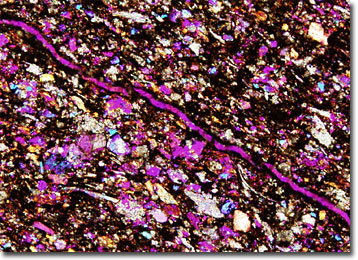Polarized Light Microscopy Digital Image Gallery
Bituminous Shale
Formed through the consolidation of silt or clay particles, shale is a common sedimentary rock that readily cleaves into thin layers along lines parallel to its bedding planes. The rock is most often gray in color, but may exhibit a range of hues due to the varying composition of the rock.

Bituminous shale is an argillaceous shale that contains bitumen, a mixture of hydrocarbons that may be used as fuel, as a paving material, or in a number of other applications. This type of shale is often found accompanying coal and, in fact, grades into bituminous coal when carbonaceous material is present in large amounts. Humans have utilized bituminous shale at various periods throughout history, though at some times much more heavily than others. In the Kimmeridge Bay area of Dorset, England, for instance, the material was used as a fuel and as a material for craftsmen even in pre-Roman times, though the Romans were responsible for the first large-scale operations in the area. Also, many years later, in 1851, Canadian geologist Abraham Gesner patented a process for extracting kerosene, which could be burned for lighting, from bituminous shale.
When bituminous shale contains kerogen it is better known as oil shale. Kerogen is a chemically complex mixture of hydrocarbons derived from organic material that can be heated to yield oil. Typically, this production of oil, which is generally referred to as syncrude, takes place at about 500 degrees Celsius. One of the earliest known references to the extraction of oil from shale was made in 1596 by a physician who claimed that the substance distilled from the rock could be utilized for healing purposes. About a century later, the first known commercial shale oil industries were developed, many of which were successful for a number of years. However, as discoveries of crude oil were made in various locations around the world, the vast majority of these operations closed down since oil fields were a much more economic source of oil than shale.
